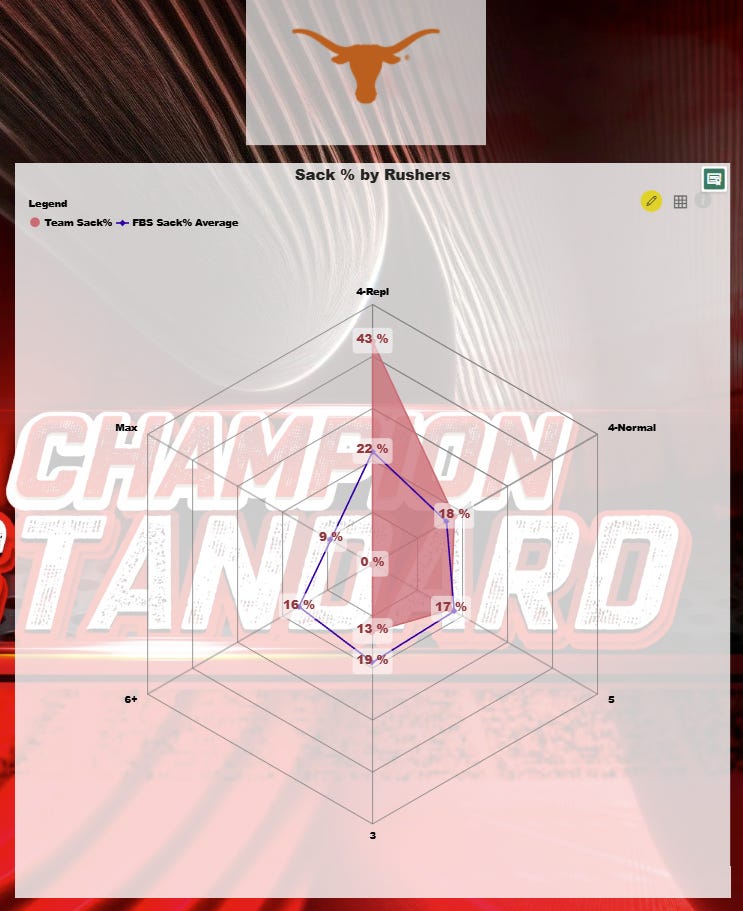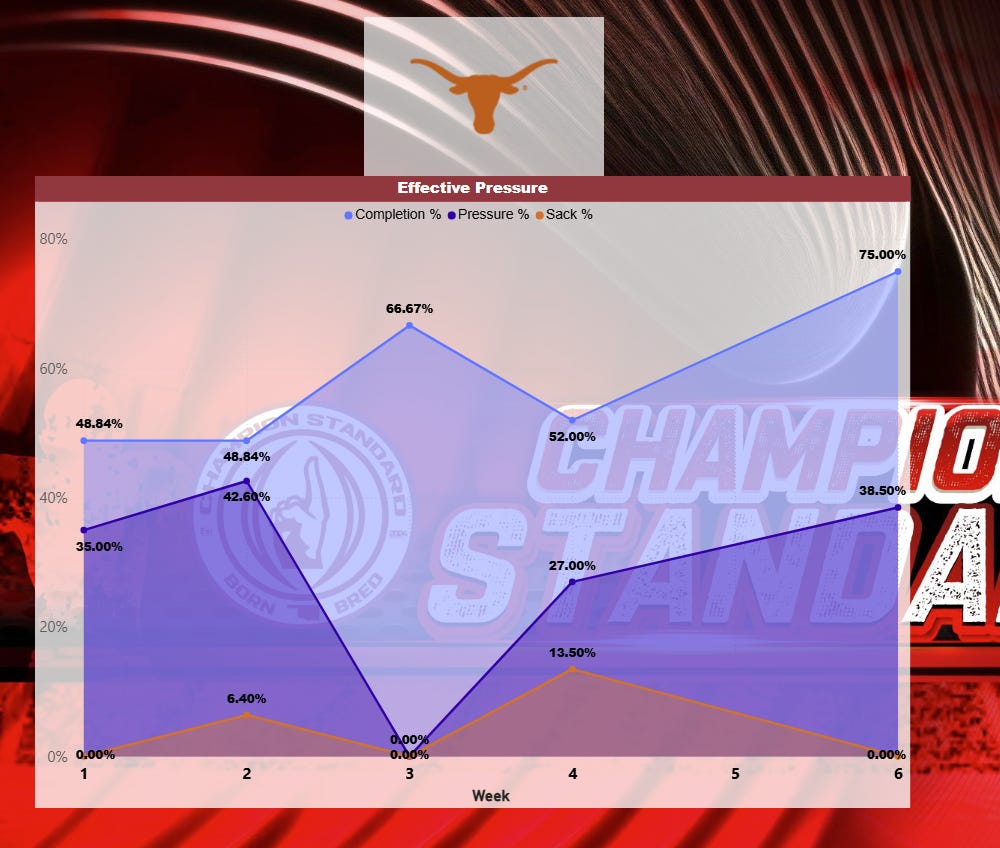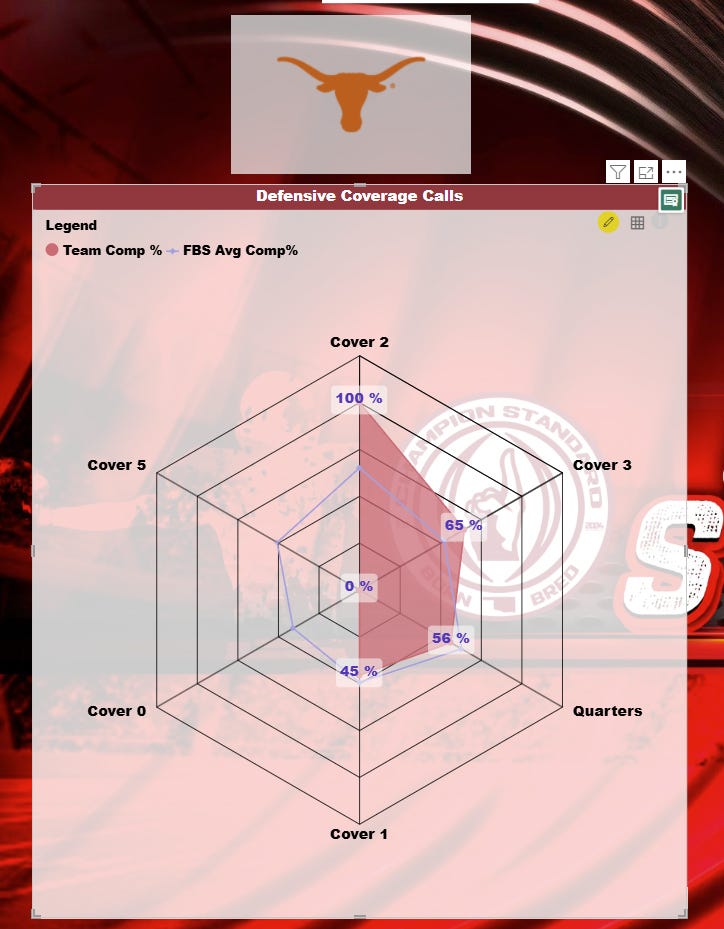Before we dive in — let’s get this out of the way. Steve Sarkisian can’t keep dodging Oklahoma’s starting quarterbacks. The man has been unbelievably lucky. If John Mateer were playing, this would likely be a win for the Sooners. I also don’t buy into the national narrative — Arch Manning isn’t as bad as the media makes him out to be, and the Texas defense isn’t as dominant as everyone thinks. They’ve got elite talents like Anthony Hill and Michael Taaffe, but their corners are suspect, and outside of Simmons and Watson, the defensive line doesn’t scare anyone.
This breakdown is a big one.. massive, actually. Grab a drink, stretch your thumbs, maybe crack your neck like you’re about to go into overtime. I’ve split it up into Setup, Run Game, and Pass Game so your brain doesn’t melt halfway through.
The Setup
The Oklahoma Sooners take on the Texas Longhorns in what promises to be another emotionally charged chapter of the Red River Rivalry. Predicting this game is nearly impossible—the hatred runs deep, and the stakes are sky-high. With the No. 6 Sooners (5-0) facing the Longhorns (3-2) in the 121st meeting, the spotlight is hotter than ever.
Quarterback Situation and Offensive Identity
Oklahoma may be without starting quarterback John Mateer, who’s recovering from a broken thumb. It’s a coin flip whether John Mateer starts, but if it’s just a pain management issue with no risk of re-injury, The Matador will ride. Mateer’s toughness is legendary in Norman—he’s the kind of quarterback who plays through pain, not around it. If he can grip the ball, he’ll be slinging it across the Cotton Bowl with fire in his eyes. This rivalry demands warriors, and Mateer fits the mold. But If he’s not able to go.
That puts sophomore Michael Hawkins Jr. back in the spotlight. Hawkins started last year’s Red River game as a true freshman and struggled in a 34-3 loss. This time, he returns with more experience, a better supporting cast, and the full confidence of head coach Brent Venables.
“He’s got experience in this rivalry,” Venables said. “We just need him to take care of the ball, make the layups, and not try to do too much. I feel great about Mike.”
Hawkins is coming off a solid outing against Kent State, throwing for 162 yards and three touchdowns, plus a rushing score. Offensive coordinator Ben Arbuckle praised his poise and preparation but noted that footwork and timing still need refinement—especially against a defense with Texas’s level of talent.
Texas Defensive Profile
Texas boasts one of the most statistically sound defenses in the country:
12.0 points allowed/game (5th nationally)
79.6 rushing yards allowed/game (11th)
181.4 passing yards allowed/game (34th)
4.3 yards per play allowed (13th)
Led by linebacker Anthony Hill Jr., edge rusher Colin Simmons, and defensive tackle Maraad Watson, the Longhorns have depth and athleticism across the board. Hill is the heart of the defense—a sideline-to-sideline playmaker with over 30 tackles and multiple sacks. Simmons brings elite speed off the edge, while Watson, a Syracuse transfer, is a massive presence inside with 14 tackles and surprising mobility.
Despite a rough outing against Florida (457 yards allowed), Texas remains focused. “We’re going to focus on us, execute, and handle our business,” Anthony Hill said.
Key Matchup: OU’s Offensive Line vs. Texas Front Seven
Texas thrives on third-down stops and has forced nine turnovers this season. Hawkins, who has yet to throw an interception in 2025, will need to stay composed under pressure. Arbuckle’s game plan will likely feature quick reads, play-action, and designed runs to keep the Longhorns off balance.
Oklahoma’s pass protection has been outstanding this season, providing stability amid quarterback uncertainty. Whether it’s protecting Hawkins—who can be impulsive under pressure—or Mateer, who may return while still nursing a thumb injury, the offensive line’s performance will be crucial. Facing a Texas front with a solid combo of speed and power, keeping the pocket clean could be the difference between victory and collapse.
Texas has recorded 11 team sacks this season, though no individual defender has more than two. Edge rusher Colin Simmons still flashes that elite bend and burst off the edge that gave Oklahoma problems a year ago. Inside, Syracuse transfer DT Marad Watson anchors the interior — a massive, agile lineman who’s racked up 14 tackles and consistently disrupts blocking schemes. But the true engine of this defense is Anthony Hill Jr. — a dynamic, sideline-to-sideline playmaker whose speed, instincts, and sheer relentlessness make him a one-man chaos creator.
Still, this defense may not be as dominant as some claim. Their blitz rate ranks 43rd nationally, sack rate is 46th, and opponents are completing 60% of their passes (44th)—despite facing weaker competition like Sam Houston, San Jose State, and UTEP. Seven of Texas’s 11 sacks have come from replacement pressures or standard four-man rushes — not heavy blitzes. Their most effective pressure packages rely on sound coverage on the back end, allowing the front to win without sending extra rushers.
Texas’ pass rush has been a rollercoaster through the first six weeks — dominant in spurts, but inconsistent overall. As the Effective pressure chart shows, when the front four gets home, completion rates plummet. But when pressure fades, opposing quarterbacks feast — evidenced by spikes to 66% and 75% completion in low-pressure weeks. When Texas rushes four effectively and the back end holds up, they look great. When either link breaks, the entire structure wobbles.
Run Game Preview:
Oklahoma’s offense has been efficient but inconsistent. Ranked 55th nationally in total offense (415.2 yards/game), the Sooners rely heavily on their passing attack (278 yards/game) while their run game continues to lag (137.2 yards/game, 97th nationally). Freshman running back Tory Blaylock has emerged as a bright spot, and wide receiver Isaiah Sategna leads the team with 359 receiving yards and three touchdowns.
Through five games, Oklahoma’s run game still lacks a clear identity. The Sooners haven’t yet established a go-to concept they can “major” in — that one bread-and-butter play to build around. Under Coach Bedenbaugh, Oklahoma’s offensive lines have traditionally thrived on the Counter scheme, but this unit is still growing into form. They’re close. Counter, by design, is a boom-or-bust play: it vacates two gaps and relies on a precise chain reaction of reads and timing. Every lineman, tight end, and back has to execute in sync for it to hit — and right now, the pieces are still coming together.
As I’ve mentioned on the podcast — and even back at the Kent State tailgate — offensive coordinators share part of the responsibility when players fail to execute. It’s their job to level out the learning curve and put guys in positions to succeed. It’s worth noting that several successful programs don’t major in Counter at all. Instead, they lean on “safer deception” runs like Wrap and Dart. Wrap involves a guard pull, while Dart uses a tackle pull — both concepts that avoid vacating multiple gaps or relying on a complex chain of reads.
Florida ran Wrap vs Texas for success..
The guard uses a skip pull here, which controls his tempo and keeps his eyes locked on the target before delivering the hit. Florida ran Wrap five times for an average of 5.8 yards per play.
And wouldn’t you know it — Oklahoma broke out Wrap for the first time all season last week against Kent State.
In fact, most teams start the season building confidence with Wrap and Dart before gradually layering in the Counter game as timing, trust, and cohesion along the offensive line develop. Florida found some good ole power football success with this play. OU should find this play helpful this week for those power success yards.
Pass Game Preview:
Through five games, Texas’ pass defense has been steady on paper but vulnerable under pressure. Statistically, they sit in the upper third of the SEC in yards per attempt and completion percentage allowed, yet much of that efficiency is built on facing lower-tier passing attacks. The Longhorns lean heavily on Cover 1 and Cover 3, forcing man-to-man matchups rather than disguising looks — a philosophy that works against average offenses but can unravel versus rhythm passing teams. Their pressure rate is below the FBS average, relying mostly on four-man rushes to generate disruption.
This radar chart visualizes Texas’ defensive coverage performance, comparing their opponent completion percentages to FBS averages. The standout takeaway: Texas is most vulnerable in Cover 2 and Cover 3, where opposing quarterbacks are completing 100% (very few attempts) and 65% of passes, both above national norms. In contrast, their Cover 1 man coverage has been the most effective, holding offenses to just 45% completions, showing that Texas fares best when playing tight, aggressive coverage.
Overall, this confirms that Texas’ secondary is structured but predictable. This should be expected with backup quarterback Michael Hawkins, similar to how Texas has approached several other opposing QBs this season. If John Mateer were under center, Texas’s defense would likely lean far more in staying balanced and utilize match coverages to counter his aggressive nature and ability to lay the ball in the basket vs Man Coverage.
For the sake of this breakdown, let’s assume Michael Hawkins gets the start. One of his key weaknesses is throwing outside the numbers. He tends to be erratic on sideline throws unless it’s a screen or flat control. At times, it’s as if he’s locked into a narrow field of vision, limiting his ability to see the full picture.
But there are three plays that stood out — and they give me real hope that Hawk has what it takes to bring this win home.
Here’s a variation of Dagger, featuring a pylon route paired with a shallow cross. Kent State is in a version of Quarters coverage, with the backside safety “stealing” over to pick up the No. 3 receiver (Sategna on the pylon). That rotation opens up the dig route underneath the vertical routes. Perfect call, clean read, and strong execution.
This was, in my opinion, Hawkins’ best throw of the day. It’s 2nd and 21 from the 26, and Oklahoma dials up a Deep Over concept paired with a Smash spacing variation to the boundary. Kent State is running a version of NTT (“Tampa”) coverage, and Hawkins stays composed — no frantic feet, just a steady pocket presence — before ripping an absolute dart. Kent State’s safety didn’t use a proper pull-through technique on the pole runner (something OU’s safeties do well), and he overruns the route entirely. Explosives against NTT are rare, which makes this play even more impressive — a high-level throw and a confident read.
Of all the core plays in the Air Raid philosophy, none fit this offense better than Mesh. We haven’t called it much this season — and only once against Kent State — but when we did, it was executed exactly how it’s meant to be taught. Too many teams butcher Mesh by having the crossers drift toward the sideline against man coverage, killing the play. Sategna, reading man, doesn’t make that mistake — instead of running toward the bleachers, he smartly bends his route toward the back pylon. That’s high-level coaching and awareness. The timing and route depth could still improve, but it’s a tremendous throw under pressure.
I’d love to see more Mesh concepts against Texas’ man-heavy looks if Hawkins gets the start. When run correctly, Mesh is virtually unstoppable, and this wide receiver group clearly feels right at home in it.
Last season, Ben Arbuckle went to the Mesh concept repeatedly against Washington — a defense that lives in MOFC Cover 1 and Cover 3 match looks. He dialed it up six times, connected on four completions, and one of them turned into a big-time explosive thanks to a creative variation known as “Traffic.”
Summary
In the end, this matchup will come down to execution and composure. Whether it’s Mateer gutting it out or Hawkins seizing the moment, Oklahoma’s path to victory will rely on balance, creativity, and discipline. The defense is already championship-caliber; now it’s about pairing that with enough offensive rhythm to keep Texas guessing. The Longhorns’ reputation doesn’t match the tape their defense is structured but beatable, their pressure inconsistent, and their corners exploitable. If Arbuckle leans into tempo, spacing, and the Air Raid staples that make this offense hum, the Sooners have more than a puncher’s chance.
Thank you for reading!
We hope to see you at the next tailgate!
BOOMER!
TEXAS SUCKS!!!
The Matador listed as "“Questionable”…





